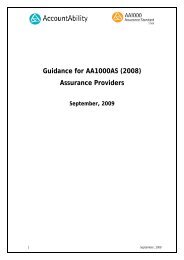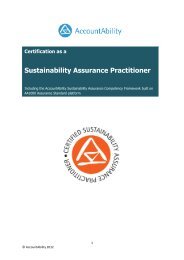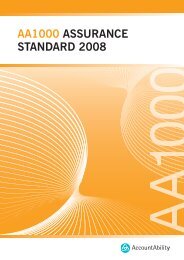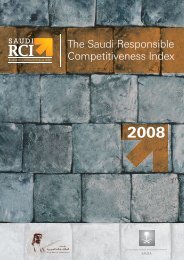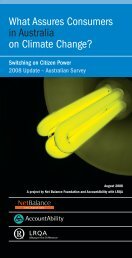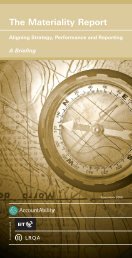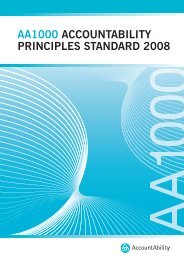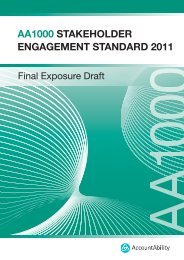The Stakeholder Engagement Manual Volume 2 - AccountAbility
The Stakeholder Engagement Manual Volume 2 - AccountAbility
The Stakeholder Engagement Manual Volume 2 - AccountAbility
Create successful ePaper yourself
Turn your PDF publications into a flip-book with our unique Google optimized e-Paper software.
Camelot's Performance Reporting<br />
STAGE 5<br />
<strong>The</strong> acid test of reporting back to stakeholders and to wider society is whether the organisation<br />
refl ects an adequate response to material issues surfaced by the engagement processes.<br />
However, the principle of responsiveness does not require that the reporting organisation<br />
agrees or complies with all stakeholder concerns and interests, but that it has responded<br />
coherently and consistently to them. Thus an adequate response should include<br />
acknowledgement of the key concerns, a prioritisation of issues (including how this was<br />
determined), what has taken place since the dialogue, benchmarks, and next steps within a<br />
fi xed timeframe.<br />
<strong>The</strong> “Our Performance ” Section of Camelot’s Social Report 2004 focuses on the extent to which the company is delivering on the<br />
expectations of the eight stakeholder groups that Camelot has identifi ed, and on what Camelot has committed to doing in the future.<br />
Against each stakeholder group, it reports on:<br />
- Camelot’s vision for the relationship with these stakeholders;<br />
- the progress made on the commitments from the previous year;<br />
- the performance against relevant key indicators and targets. Indicators are consistent year on year to show trends over time;<br />
- details of any consultation undertaken in 2003/2004, the issues stakeholders have raised, and Camelot’s responses;<br />
- commitments for the next year.<br />
<strong>The</strong>re are various guidelines on reporting. <strong>The</strong> most recognised internationally<br />
are the Global Reporting Initiative Sustainability Reporting Guidelines<br />
(www.globalreporting.org), which – together with various guidance documents<br />
and technical protocols – provide extensive guidance to reporting processes,<br />
including on principles and indicators for reporting. Th e GRI itself involves an<br />
extensive, global multi-stakeholder process contributes to the ongoing revision<br />
of the GRI Guidelines.<br />
A primary goal of reporting is to contribute to an ongoing stakeholder dialogue. Reports<br />
alone provide little value if they fail to inform stakeholders or support a dialogue that infl uences<br />
the decisions and behaviour of both the reporting organisation and its stakeholders. However,<br />
GRI clearly recognises that the engagement process neither begins nor ends with the<br />
publication of a sustainability report.<br />
Taken from the “GRI Sustainability Reporting Guidelines” 2002<br />
THE PRACTITIONER'S HANDBOOK ON STAKEHOLDER ENGAGEMENT | 125



